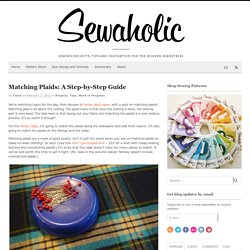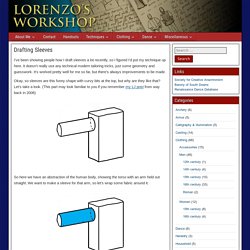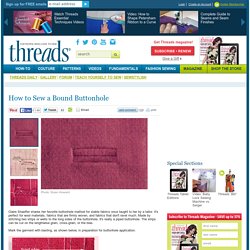

Drafting - An Epilogue. One thing to remember: there is no single correct way of drafting.

Another way of saying it is that everyone drafts differently. There is a lot of personal preference or personal style in it. Some people always like roomier drafts. Some people always make snug slopers. Some people draft big sleeve caps with a lot of ease. Different books, written by different authors, will show you different templates for blocks and slopers. Tip: Make your sloper snug. One of the consequences of only making your own sewing patterns and never using commercial patterns is not knowing how much fabric you'll need when you finally get around to sewing your garment. Matching Plaids: A Step-by-Step Guide. We’re switching topics for the day, from blouses to tartan plaid capes, with a post on matching plaids!

Matching plaid is all about the cutting. The good news is that once the cutting is done, the sewing part is very easy! The bad news is that laying out your fabric and matching the plaids is a very tedious process. It’s so worth it though! For the Tartan Cape, I’m going to match the plaids along the sideseams and side front seams. Matching plaids are a mark of good quality. Video: How to Fit Sleeves the Hip-Hop Way. Ad-enabled single clip widescreen player Video Length: 4:42 Produced by: Evamarie Gomez and Carol Fresia; Videographer: Gary Junken In this video extra from "A Fresh Way to Fit Sleeves," Threads #183 (February/March 2016), contributing editor Kenneth D.

King models a pair of "hip-hop" pants to demonstrate how fitting pants is like fitting a sleeve: Sometimes more space doesn't equal more comfort or mobility. Threads Magazine, editor Posted on in online extras, garment construction, tips & tricks, All Videos, fitting, , Kenneth D. Drafting Sleeves – Lorenzo's Workshop. I’ve been showing people how I draft sleeves a lot recently, so I figured I’d put my technique up here.

It doesn’t really use any technical modern tailoring tricks, just some geometry and guesswork. It’s worked pretty well for me so far, but there’s always improvements to be made. Okay, so sleeves are this funny shape with curvy bits at the top, but why are they like that? Let’s take a look. (This part may look familiar to you if you remember my LJ post from way back in 2006) So here we have an abstraction of the human body, showing the torso with an arm held out straight. Just to keep things simple, we’ll put the seam at the bottom of the arm. Perhaps unsurprisingly, we have a rectangle. Subtleties in Drafting: Sleeves. Hello, everyone!

More drafting today, but not garment deconstruction this time. Instead, we're simply going to meander through some of the subtleties in drafting. Drafting is simultaneously an exact science and a nebulous art. On one hand, it is systematic and linear: there are rules, standard sequences, tables, guidelines and even formulae to enable a person to go from body measurements to custom-fit garments. You can read books that teach you all about these. On the other hand, drafting is also completely subjective.
How to Sew a Bound Buttonhole. Sloan Howard Photo: Sloan Howard Claire Shaeffer shares her favorite buttonhole method for stable fabrics once taught to her by a tailor.

It's perfect for wool materials, fabrics that are firmly woven, and fabrics that don't ravel much. Made by stitching two strips or welts to the long sides of the buttonhole, it's really a piped buttonhole. The strips can be cut on the lengthwise grain, cross-grain, or the bias. Mark the garment with basting, as shown below, in preparation for buttonhole application. 1. 2. Fitted Sleeve Sloper: part 2 – built-in gusset. So, as I was saying, I also made some vanity tweaks to my Kenneth King fitted sleeve sloper, which led eventually to an experiment with sleeve gusset.

Slimming Down While the fitted sleeve that was drafted as instructed is fine for most people, it has a little bit more ease in the upper arm & elbow than I wanted. Because my hip is relatively narrow, I want to de-emphasize my wider top to appear more proportional. My arms are relatively thin, so I thought I’d push the envelop & see how fitted I can go before it becomes a straitjacket. I slimmed the sleeve down a tinsy bit at the elbow instead of having a straight line going from bicep to wrist. And here is a summary of the changes I’ve made… The Legend of the Anatomical Armhole. Tips for Sewing with Vinyl. It’s been on my mind for a while now because my local fabric store has a selection of vinyl, ideally for the local boating industry, but there’s no reason I couldn’t use it to make some awesome bags.

I’d heard that vinyl was difficult to sew with so I’ve been putting it off until I could assemble the right supplies. Now there is a project on the work-table that I think you’ll love and the pattern for the bag you see above is coming soon. Before you jump right in, here are a few tips and tricks to make sewing with vinyl and faux leathers nice and simple. Recommended supplies for working with vinyl Tips for sewing with vinyl Needles – Firstly, vinyl is thicker than cotton so we need to be mindful of creating too much thickness and too many layers so that the sewing machine might struggle.
If you want to learn more about needle sizes and types, there is a very good Schmetz download available on Craftsy here. On Fitting Sleeves. Your favorite off-the-rack fashions hold the secret to perfectly shaped sleeve caps and armholes. by Peggy Sagersexcerpted from Threads #107, pp. 55-57 Sewers I meet through my seminars always tell me they can't get their set-in sleeves to fit.

They're too small, too tight, don't allow mobility... Having compared the sleeves and armholes provided in current commercial patterns to those typically used in ready-to-wear, I'm not surprised. I've found that almost all ready-to-wear jackets and blouses have lower armholes and wider sleeves than the typical pattern for a similar garment. Don't measure yourself, measure what fitsI've met hundreds of women who can tell me their measurements, but don't know the measurements of garments that fit them the way they like.